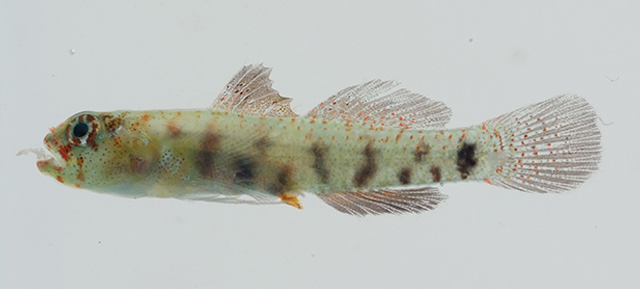| Gobiidae (Gobies), subfamily: Gobiinae |
| 1.03 cm SL (male/unsexed) |
|
benthopelagic; depth range 3 - 5 m |
| Eastern Central Pacific: French Polynesia, Niue, Tonga and Fiji. |
|
Dorsal spines (total): 7-7; Dorsal soft rays (total): 9-10; Anal spines: 1-1; Anal soft rays: 8-9. This species is distinguished from its congeners by the following characters: cephalic sensory-canal pore pattern group 2, missing only is the IT pore; dorsal/anal ray formula 9/8; some pectoral-fin rays are branched; absence of the fifth pelvic-fin ray or may be rudimentary; trunk with approximately 8 distinct subcutaneous bars, the 2 bars originating over anterior half of anal fin, extending vertically to lateral midline or beyond, and 3 shorter bars originating over caudal peduncle, last of which often being confluent with prominent spot over the centre of the caudal peduncle; no distinct pair of dark spots on pectoral-fin base; male urogenital papilla with prominent lateral folds, cuplike in appearance (Ref. 94084). |
| Occurs mainly from shallow reefs. At Moorea, collected almost exclusively from patches of rubble around shallow lagoon reefs. Also found in tidepools and adjacent coral reef; rocky shore with porous volcanic rock and large table corals in water beneath rocks (Ref. 94084). |
|
(Ref. 96402)
|
| harmless |
|
Source and more info: www.fishbase.org. For personal, classroom, and other internal use only. Not for publication.
Page created by Jen, 05.08.02,
php script by kbanasihan 06/09/2010 ,
last modified by
dsantos, 20/08/10

